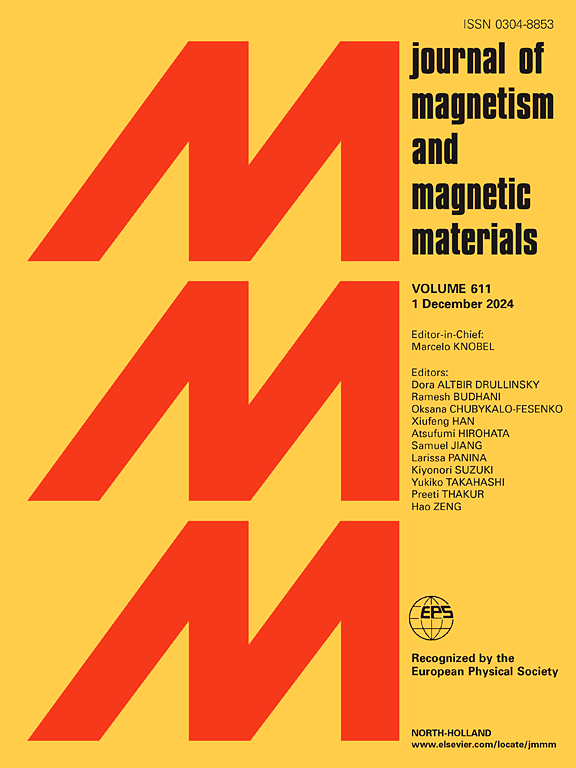Reductant assisted hydrothermally synthesized Ni-Fe based magnetic nanoalloys for tunable magnetization
IF 2.5
3区 材料科学
Q3 MATERIALS SCIENCE, MULTIDISCIPLINARY
引用次数: 0
Abstract
A template-free, reductant-assisted hydrothermal method has been employed for the first-time to synthesize compositionally and magnetically tunable Ni1-xFex (x = 0.25, 0.5, and 0.75) nanoalloys. The structural evidences from X-ray diffraction (XRD) patterns while confirm a single phase Face Centered Cubic (FCC) structure for x = 0.25 and 0.5, coexistence of 90.53 % FCC and 9.47 % Body Centered Cubic (BCC) are identified for x = 0.75. High-resolution scanning electron microscopy (HRSEM) demonstrates the particle size in the nano regime with reasonable chemical homogeneity of the alloys. From X-ray photoelectron spectroscopy (XPS), we observe the metallic Ni and Fe along with partial surface oxidation. Field dependent magnetization measurements reveal well saturated hysteresis with high saturation magnetization (Ms) of 0.94, 1.59, and 0.86 μB/f.u. for x = 0.25, 0.5 and 0.75 respectively compared to bulk alloys. Such high Ms is well explained by itinerant electron model showing a good agreement between experiment and theory. The composition dependent change in magnetization aligns with Slater-Pauling behavior and confirms the invar effect. Further, the fit of Ms to Law of Approach to Saturation (LAS) estimates the effective anisotropy (Keff) as 230, 760, and 430 kJ/m3 for x = 0.25, 0.5 and 0.75 respectively. The observed tunability of magnetization, along with low hysteresis loss, highlights the potential of these soft magnetic nanoalloys for applications in magnetic sensors and data storage technologies.
还原剂辅助水热合成可调磁化镍铁基磁性纳米合金
本文首次采用无模板、助还原剂的水热法合成了磁性可调的Ni1-xFex (x = 0.25、0.5和0.75)纳米合金。x射线衍射(XRD)结果表明,x = 0.25和0.5为单相面心立方(FCC)结构,x = 0.75为90.53% FCC和9.47%体心立方(BCC)共存。高分辨率扫描电镜(HRSEM)显示了合金的纳米级粒度和合理的化学均匀性。从x射线光电子能谱(XPS)中,我们观察到金属Ni和Fe的部分表面氧化。磁场相关磁化测量表明,饱和磁滞性能良好,饱和磁化强度(Ms)分别为0.94、1.59和0.86 μB/f.u。对于x = 0.25, 0.5和0.75分别与大块合金。流动电子模型很好地解释了这一现象,实验与理论吻合良好。磁化强度随成分的变化与斯莱特-鲍林行为一致,证实了因瓦效应。此外,Ms对接近饱和定律(LAS)的拟合估计,当x = 0.25、0.5和0.75时,有效各向异性(Keff)分别为230、760和430 kJ/m3。观察到的磁化可调性,以及低磁滞损耗,突出了这些软磁纳米合金在磁传感器和数据存储技术中的应用潜力。
本文章由计算机程序翻译,如有差异,请以英文原文为准。
求助全文
约1分钟内获得全文
求助全文
来源期刊

Journal of Magnetism and Magnetic Materials
物理-材料科学:综合
CiteScore
5.30
自引率
11.10%
发文量
1149
审稿时长
59 days
期刊介绍:
The Journal of Magnetism and Magnetic Materials provides an important forum for the disclosure and discussion of original contributions covering the whole spectrum of topics, from basic magnetism to the technology and applications of magnetic materials. The journal encourages greater interaction between the basic and applied sub-disciplines of magnetism with comprehensive review articles, in addition to full-length contributions. In addition, other categories of contributions are welcome, including Critical Focused issues, Current Perspectives and Outreach to the General Public.
Main Categories:
Full-length articles:
Technically original research documents that report results of value to the communities that comprise the journal audience. The link between chemical, structural and microstructural properties on the one hand and magnetic properties on the other hand are encouraged.
In addition to general topics covering all areas of magnetism and magnetic materials, the full-length articles also include three sub-sections, focusing on Nanomagnetism, Spintronics and Applications.
The sub-section on Nanomagnetism contains articles on magnetic nanoparticles, nanowires, thin films, 2D materials and other nanoscale magnetic materials and their applications.
The sub-section on Spintronics contains articles on magnetoresistance, magnetoimpedance, magneto-optical phenomena, Micro-Electro-Mechanical Systems (MEMS), and other topics related to spin current control and magneto-transport phenomena. The sub-section on Applications display papers that focus on applications of magnetic materials. The applications need to show a connection to magnetism.
Review articles:
Review articles organize, clarify, and summarize existing major works in the areas covered by the Journal and provide comprehensive citations to the full spectrum of relevant literature.
 求助内容:
求助内容: 应助结果提醒方式:
应助结果提醒方式:


